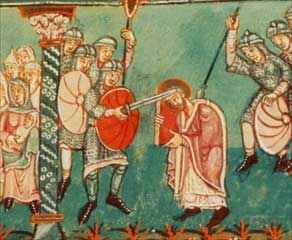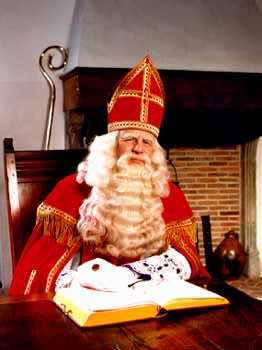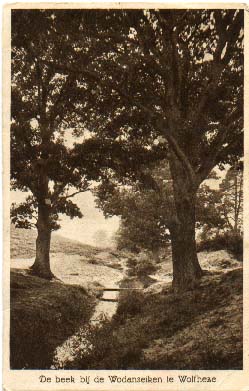The eastern Germans left some beautiful writings; both the Dietrich/Thidrek saga and the Beowulf saga are of Gothic origin.
Gothic is also one of the oldest Germanic languages of which written records exist (Codex Argenteus or Wulfila bible).
The eastern Germans were real travellers, their place of origin is believed to have been Scandinavia and/or the Vistula area but as soon as they experienced overpopulation or famine they formed a subgroup that would then migrate to another area to ensure the survival of both groups, this tactic was also used by the other Germanic tribes but the Eastern group is especially known for this; they travelled for long distances and from Scandinavia(?) they first migrated into eastern Europe, then to the Balkans, and after that to as far as France and Spain, which was a long way in a time without cars or airplanes.
Celtic influences on the western Germanic tribes:
During its early beginning the Germanic culture was influenced by the Celtic Hallstatt culture, eventually the Germanic identity became stronger in northern Europe which caused this influences to diminish, though Celtic influences continued in the border areas (like the Netherlands and southern Germany), where the Germans even adopted some minor Celtic godesses like the horse godess Epona, Dutch archeologists have also discovered some Celtic coins in the Netherlands that the Germans have probably used to trade with the Celts since they did not use any money themselves in that area.
Some people claim that Germanic art has been heavily influenced by Celtic art but that is total nonsense; although they may have exchanged some artistical inspirations with the Celts the Germans definitely had their own art styles that were already used in earlier times, a more likely explanation is that some aspects of the Germanic and Celtic art have been derived from their common Indo-European roots and native (Pre-Indo-European) art forms.
It has even been claimed that there was a Celtic presence in Denmark and some books about the Celts display a map of Europe with a Celtic "culture island" in southern Denmark; this theory is purely based on a handfull of Celtic findings in that area like the Gundestrup chalice, a beautifully decorated Celtic pot that probably ended up there as warbooty or via trade, personally I find this theory highly questionable but some people seem to believe in it.
Germanic influences on their neighbours:
The Germans on their turn also influenced other peoples, the culture of the early Slavonic and Baltic peoples contained a lot of Germanic influences, for instance the Baltic thundergod Perkunas had a lot in common with the Germanic god Thunaraz, the Slavonic stormgod Perunu also had lots of resemblances with Thunaraz, although the various storm- and thunder gods in early European religions have probably been derived from a common (Indo-European or Pre-Indo-European) origin there are still lots of typically Germanic influences in the religions of the peoples that lived near them, especially the early Baltic culture and religion had many things in common with their Germanic counterparts.
There have also been discoveries of Turkish and Bulgarian runic writings which looked much like the Germanic runes and can still not be properly explained.
In a later period the Vikings founded a small empire in Russia which also greatly influenced the Slavs and even the nearby Byzantine empire.
Roman influences on the western Germanic tribes:
The Romans never succeeded in conquering Germania though they did temporarily occupied parts of the Germanic lands, my country the Netherlands is a good example of an area where the cultures of the Germans and Romans melted together.
There was a heavy hostility between the Romans and the Germans and in the 1st century Aulus Hirtius even wrote that "the Germans never refuse to help someone fight against the Romans", despite this the Germans in Germania Inferior (the Roman province that contained parts of the low countries and northern France) also desired the luxuries that the Romans had brought there and were influenced by their occupiers.
They started trading with the Romans and took over some of their customs, the Romans on their turn were impressed by the tall, fierce Germanic warriors and recruited a lot of them into the Roman army, they also traded their goods for slaves, hides, and amber that the Germanic tribes collected at the coastal areas of the Northsea.
The Gallo-Roman occupiers also took over some Germanic customs and they even erected sanctuaries for Germanic gods; in the Netherlands Roman altars have been found that were dedicated to Germanic godesses like Nehalennia and Hurstrge, on their turn the Germans also took over some Celtic and Roman gods.
The Roman influence on the Germanic culture as a whole was rather small since they only occupied some Germanic border territories, though their influence sometimes reached further over the border.
Most of the "Roman" influences in modern countries with a Germanic background have been added later during the Middle Ages, the Renaissance period, and the Napoleontic age in which lots of French and Latin words and influences were introduced because they were considered chic in that time, many European nobles even started to speak French amongst eachother instead of their native language because French sounded so very "classy".
Science and the medical world also introduced a lot of Latin influences, think about plant names, animal names, medicine names, etc. but this also occured in a much later period.
Christian influences on Germanic culture and vice versa:
Christianity have had lots of influences on the Germanic culture, it started under the Romans but in a later period, after the Great Migrations, Christianity became almost destructive to Germanic culture and religion; polytheďsm was not allowed, so the Germans were not allowed to believe in their gods anymore, women were seen as manipulating liars, so the high position of women in Germanic society deteriorated, nature was not seen as something holy by the Christians but rather as something that should be overcome, so holy trees dedicated to Germanic gods were chopped down and holy forests, cliffs, and even mountains were "purified" from their "evil" forces by priests who sprinkled holy water all over the place, beautiful ancient statues, temples, writings, altars, etc. were destroyed, (a good example is the destruction of the Irminsul, a holy pillar of the Saxons) Gođi's (Germanic priests) and Seiđkona's (women who practiced magic) were seen as witches or devilworshippers and were often burned alive at the stake, actually the Germans had two choices; converting to Christianity, or death.
 The early Christians did everything in their power to destroy the heathen religion, and they mostly succeeded in it.
The early Christians did everything in their power to destroy the heathen religion, and they mostly succeeded in it.Please don't get me wrong; I'm speaking about Medieval Christianity here, not the modern version, it is just a hard fact that the Christian religion is responsible for destroying some of the oldest religions in the world, not only the Germanic religion but also many others like for instance the Celtic, Slavonic and Roman religions and the beautiful ancient cultures of south- and central America.
It is true that some heathens voluntarily converted, but most of them only did it at swordpoint or for economical reasons; for instance, some Germanic kings converted because they were offered lots of money, and Iceland was converted by high economical pressure and boycot.
The conversion did not go without struggle however, when the Anglo-Saxon bishop Bonifatius (whose real name was Wynfrith) tried to convert the Frisians in 754AD, he chopped down a holy tree dedicated to Wodan to show the heathens that their god did not protect his tree and thus did not exist; the Frisians became so angry that Bonifatius had to flee being chased by the entire village, at the city of Dokkum Bonifatius was caught and as a last resort he held the bible over his head and asked his god to protect him; nothing happened and he was killed by the Frisians who probably laughed over this irony.
Germanic influences in our modern culture:
Some parts of the "pagan" Germanic culture could not be destroyed because they were so deeply rooted that everybody refused to abandon them, so they were integrated into Christian holidays; during Easter we still practice lots of Germanic rituals like painting eggs and lighting Easter fires, and Christmas has the Christmas tree, and did you really think Santa Claus has something to do with the birth of Jesus?
The Dutch once founded a colony in America that they named Nieuw-Amsterdam, and on December the 5th they celebrated "Sinterklaas" (Saint Nicolaas) there, a Christianized version of the Germanic Jól celebrations, later Nieuw-Amsterdam was turned over to the English who named it New-York, and the English also took over the word "Sinterklaas" and changed it into "Santa Claus", which was easier to pronounce for them, the English also had their own (non-Christianized!) version of the Germanic Jól celebrations that featured an old man with a grey beard and a green cloak (alternative version of Wodan) who had little elf-like helpers (Alfen), this English Christmas celebration was mixed with the Dutch Sinterklaas celebration which resulted in the new name "Santa Claus", this beautiful piece of folklore continued to modern times until it was commercially exploited by a cola company that turned the old grey man into a fat man with a white beard, and of course his green cloak became an outfit in the red-and-white colours of the company.
 Although many aspects of the Germanic culture (especially the religious parts) were lost there is still much of it left and there are many modern countries whose heritage directly descends from their Germanic ancestors, but unfortunately our Germanic heritage is nowadays taboo in most countries because of its abuse by the nazi's and the unjust association with extremist ideologies that followed on that; however, it is still there: a lot of our holidays and customs are of Germanic origin like giving presents at Christmas and birthdays.
Although many aspects of the Germanic culture (especially the religious parts) were lost there is still much of it left and there are many modern countries whose heritage directly descends from their Germanic ancestors, but unfortunately our Germanic heritage is nowadays taboo in most countries because of its abuse by the nazi's and the unjust association with extremist ideologies that followed on that; however, it is still there: a lot of our holidays and customs are of Germanic origin like giving presents at Christmas and birthdays.The Christmas tree is also a remnant of the Germanic culture; trees were holy to the Germans and during the celebrations of the Wintersolstice (Jól or Yule) they used to decorate a tree outside and put offerings to the gods at its foot, later this custom was adapted by cutting the tree down and bringing it into the house.
Other customs of Germanic origin are the lights in the Christmas tree, mistletoe, singing songs around the fire, being together with family, I once had a little quarrel with a Christian man after I had claimed that most of the cozy and enjoyable things we do at Christmas are of heathen origin...
 In the Netherlands and Belgium the people always celebrate "Sinterklaas" at December the 5th.
In the Netherlands and Belgium the people always celebrate "Sinterklaas" at December the 5th.Sinterklaas is a saint dressed in a red robe bringing presents to the children together with his funny black helpers ("zwarte Pieten;" or black Petes) who toss "pepernoten" (peppernuts: some sort of small cookies) through the room for the children to collect, this festival has much in common with Santa Claus; both Sinterklaas and Santa Claus are based on the Germanic "Wild Hunter" myth in which Wodan rode through the skies and over the rooftops with his eightlegged horse Sleipnir in the Wild Hunt, a happening that was believed to take place in the time we now celebrate Christmas and new year.
I don't know if this is also a custom in other European countries but in the Netherlands it is tradition to decorate a bundle of twigs ("Paastak" or Easter branch) and hang it near the fireplace at Easter, which is definitely a trace of the ancient fertility rituals that were held in those times.
Actually, the English word "Easter" comes from "Eostre", which was the Anglo-Saxon name for Ostara, a nature godess to whom a holiday was dedicated that was held at the same time as Easter, the German word "Ostern" is also derived from her.
Eggs, rabbits, and chickens were also holy to Ostara, and guess what the symbols of Easter are? right! eggs, rabbits, and chickens.
In the Netherlands children still hold processions during Easter in which they carry decorated sticks with a piece of bread in the form of a chicken on the tip, when I was a little boy I also took part in those processions and most of the rituals we performed were of heathen origin, I wouldn't be surprised if those processions were once held in honour of Ostara, the godess of Spring.
The Easter bunny still brings eggs to the children and the painting of eggs is also a remnant of the ancient Spring celebrations; in those times the eggs were painted and hidden in the field to fertilize the Earth (the egg was associated with fertility and life since living creatures were born out of them in the form of chicks).
Carnival; dressing up in costumes, drinking and partying are all parts of Germanic new year and fertility rites, and why do we light huge bonfires at new year? and why do we make noise with fireworks, horns, or drums at new year? and why do people dance around Maypoles in spring? all of them are surviving remnants of the ancient culture of our ancestors.


 Before the culture that we now call "Germanic" came into existence northern Europe was inhabited by several related cultures, this cultures were indirect descendants of the native Funnelbeaker culture (3400BC to 2850BC) but they also had many Indo-European influences in their culture and language.
Before the culture that we now call "Germanic" came into existence northern Europe was inhabited by several related cultures, this cultures were indirect descendants of the native Funnelbeaker culture (3400BC to 2850BC) but they also had many Indo-European influences in their culture and language.